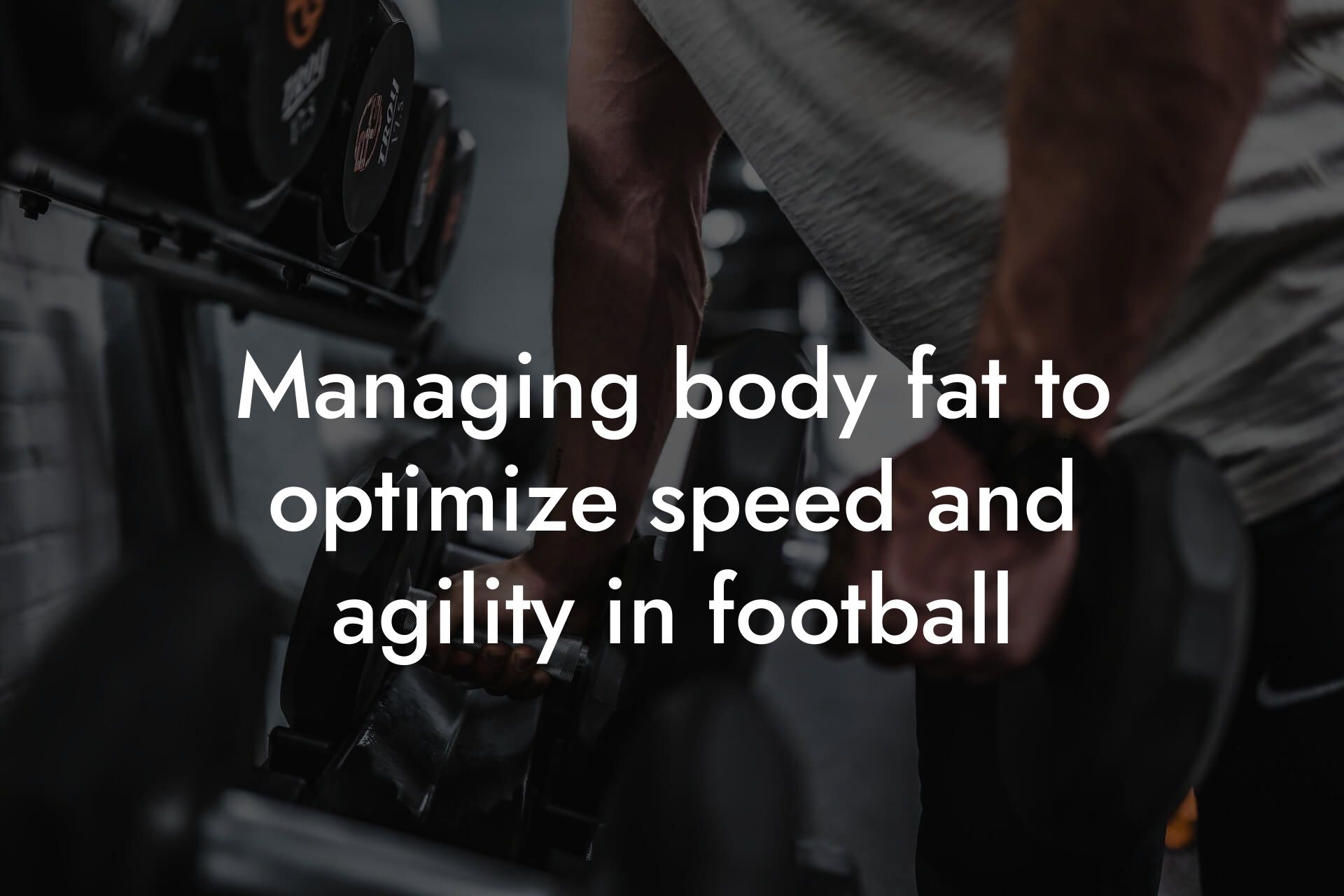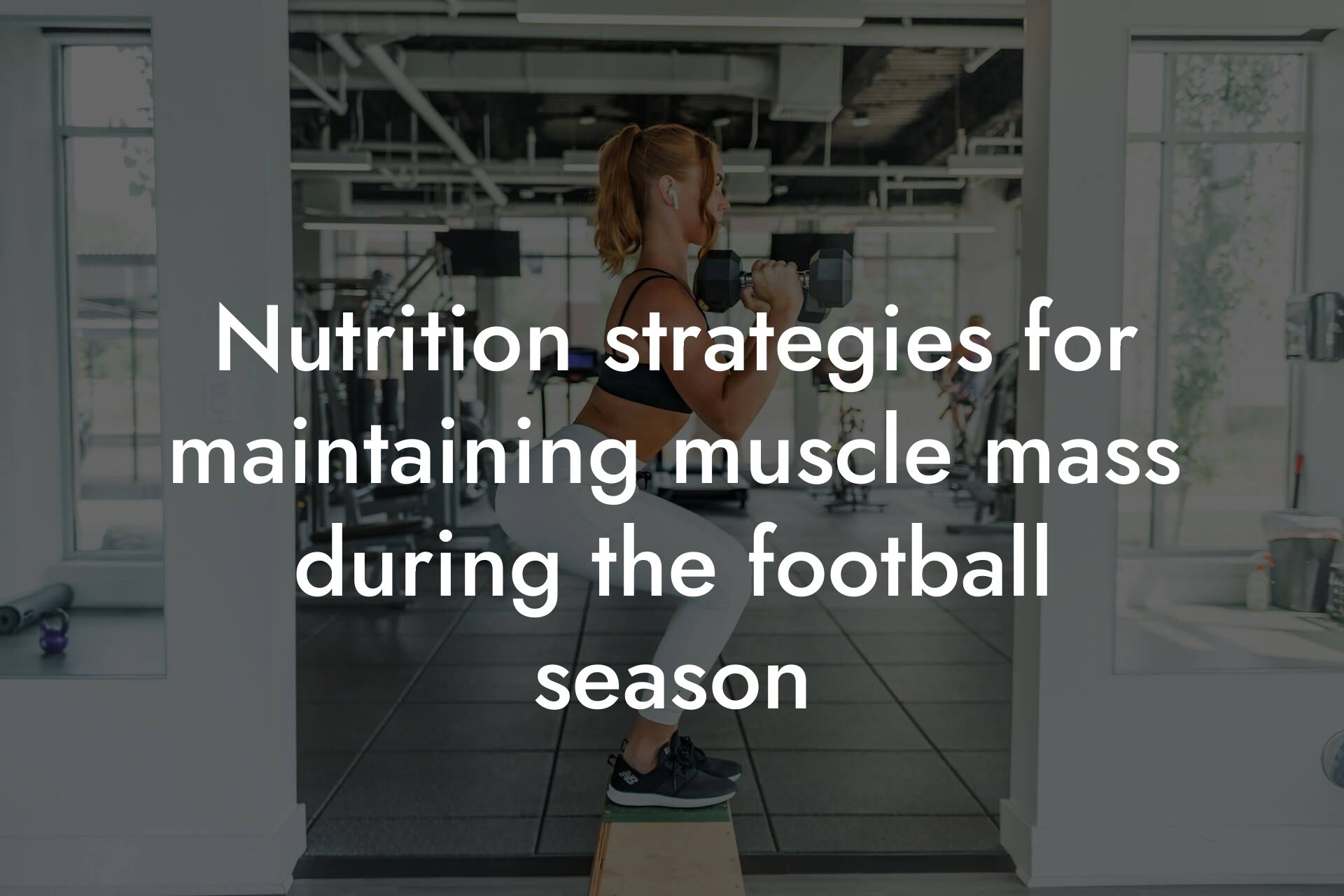As a high-earning professional interested in optimizing your physical appearance and athletic performance, understanding the importance of body composition in football cannot be overstated. Body composition refers to the percentage of fat mass versus lean mass in the body, and it plays a critical role in determining an athlete's overall performance on the field. In this article, we'll delve into the significance of body composition in football, how it affects performance, and how DEXA scanning can provide valuable insights to help you take your game to the next level.
Table of Contents
- What is Body Composition?
- The Impact of Body Composition on Football Performance
- Body Composition and Injury Risk
- The Role of DEXA Scanning in Body Composition Analysis
- How DEXA Scanning Can Improve Football Performance
- Case Studies: The Impact of Body Composition on Football Performance
- Takeaway: How Tano Performance Group Can Help
- Frequently Asked Questions
What is Body Composition?
Body composition is the proportion of fat mass to lean mass in the body. Fat mass includes stored energy in the form of adipose tissue, while lean mass encompasses muscle mass, bone density, and water. A healthy body composition is essential for optimal athletic performance, as it directly affects an athlete's speed, agility, strength, and endurance. In football, a high percentage of lean mass is desirable, as it enables athletes to generate more power, speed, and agility on the field.
The Impact of Body Composition on Football Performance
Athletes with a high percentage of body fat may experience decreased performance due to increased weight, reduced power output, and impaired endurance. Excess body fat can also increase the risk of injury, as it puts additional stress on joints and muscles. On the other hand, athletes with a high percentage of lean mass tend to exhibit improved performance, as they can generate more force, speed, and agility. This is because lean mass is directly related to muscle strength, power, and endurance.
Body Composition and Injury Risk
Research has shown that athletes with a higher percentage of body fat are more prone to injuries. This is because excess body fat increases the stress on joints and muscles, making them more susceptible to strains, sprains, and other injuries. In football, injuries can be devastating, leading to missed games, lost playing time, and decreased overall performance. By maintaining a healthy body composition, athletes can reduce their risk of injury and stay on the field longer.
The Role of DEXA Scanning in Body Composition Analysis
DEXA (Dual-Energy X-ray Absorptiometry) scanning is a non-invasive, highly accurate method for measuring body composition. DEXA scans use low-level X-rays to measure bone density and body composition, providing a detailed breakdown of fat mass, lean mass, and bone density. This information is invaluable for athletes, as it enables them to identify areas for improvement, track changes in body composition over time, and make data-driven decisions about their training and nutrition.
How DEXA Scanning Can Improve Football Performance
DEXA scanning can help football athletes optimize their body composition in several ways. By identifying areas of excess body fat, athletes can target specific training and nutrition strategies to reduce fat mass and increase lean mass. DEXA scanning can also help athletes monitor changes in body composition over time, allowing them to adjust their training and nutrition programs accordingly. Additionally, DEXA scanning can provide valuable insights into bone density, which is critical for athletes who participate in high-impact sports like football.
Case Studies: The Impact of Body Composition on Football Performance
Several studies have demonstrated the importance of body composition in football performance. One study published in the Journal of Strength and Conditioning Research found that football players with a higher percentage of lean mass exhibited improved sprint performance and agility compared to players with a higher percentage of body fat. Another study published in the International Journal of Sports Physiology and Performance found that football players who underwent a 12-week training program focused on reducing body fat and increasing lean mass experienced significant improvements in acceleration, speed, and agility.
In conclusion, body composition plays a critical role in football performance. Athletes with a high percentage of lean mass tend to exhibit improved performance, while those with a high percentage of body fat may experience decreased performance and increased injury risk. DEXA scanning is a valuable tool for athletes, providing a detailed breakdown of body composition and enabling data-driven decisions about training and nutrition. By optimizing body composition, football athletes can take their game to the next level, improving performance, reducing injury risk, and achieving their athletic goals.
Takeaway: How Tano Performance Group Can Help
At Tano Performance Group, we understand the importance of body composition in football performance. Our state-of-the-art DEXA scanning technology provides athletes with a comprehensive breakdown of their body composition, enabling them to make informed decisions about their training and nutrition. Our team of experts works closely with athletes to develop personalized training and nutrition programs tailored to their specific needs and goals. Whether you're a professional football player or an aspiring athlete, we can help you optimize your body composition and take your performance to the next level. Contact us today to learn more about our DEXA scanning services and how we can help you achieve your athletic goals.
Frequently Asked Questions
What is body composition, and why is it important in football performance?
Body composition refers to the percentage of fat and lean mass in the body. In football, having an optimal body composition is crucial as it directly affects speed, agility, power, and endurance. A high percentage of body fat can hinder performance, while a high percentage of lean mass can enhance it.
How does body composition affect speed and agility in football players?
A higher percentage of body fat can increase the energy expenditure required for movements, reducing speed and agility. On the other hand, a higher percentage of lean mass can improve muscle power and acceleration, enhancing speed and agility.
What is the ideal body composition for a football player?
The ideal body composition for a football player varies depending on the position and individual goals. However, a general guideline is to aim for a body fat percentage between 6-12% for males and 16-23% for females, with a high percentage of lean mass.
How can I measure my body composition?
There are several methods to measure body composition, including dual-energy X-ray absorptiometry (DXA), skinfold measurements, bioelectrical impedance analysis (BIA), and hydrostatic weighing. It's essential to consult with a qualified professional to determine the best method for you.
What is the relationship between body composition and injury risk in football?
Research suggests that football players with a higher percentage of body fat are more prone to injuries, particularly in the lower extremities. This is because excess body fat can increase the stress on joints and muscles, making them more susceptible to injury.
How can I improve my body composition for football performance?
To improve body composition for football performance, focus on a balanced diet that includes plenty of protein, complex carbohydrates, and healthy fats. Additionally, incorporate a strength and conditioning program that targets muscle growth and development.
What role does nutrition play in body composition for football performance?
Nutrition plays a critical role in body composition for football performance. A well-planned diet can help support muscle growth and development, while also promoting fat loss and optimal body composition.
How can I maintain my body composition during the off-season?
To maintain body composition during the off-season, continue to prioritize a balanced diet and regular exercise. Focus on maintaining muscle mass through strength training and high-intensity interval training (HIIT).
What is the impact of body composition on football performance in different positions?
Body composition requirements vary depending on the position. For example, goalkeepers may require a higher percentage of body fat for added protection, while midfielders may require a higher percentage of lean mass for increased endurance.
How does body composition affect endurance and stamina in football?
A higher percentage of lean mass can improve endurance and stamina in football, as it increases the body's ability to utilize oxygen and generate energy. Conversely, a higher percentage of body fat can reduce endurance and stamina.
What is the relationship between body composition and power output in football?
Research suggests that a higher percentage of lean mass is associated with increased power output in football. This is because lean mass is directly related to muscle cross-sectional area, which is a key determinant of muscle power.
How can I use body composition to optimize my football training?
Use body composition data to tailor your training program to your individual needs. For example, if you have a high percentage of body fat, focus on fat loss and conditioning exercises. If you have a high percentage of lean mass, focus on strength and power training.
What is the impact of body composition on football performance at different ages?
Body composition requirements vary depending on age. For example, younger players may require a higher percentage of lean mass for growth and development, while older players may require a higher percentage of body fat for added protection and support.
How does body composition affect mental performance in football?
Research suggests that a healthy body composition is associated with improved mental performance in football, including reduced anxiety and depression, and improved mood and cognitive function.
What is the relationship between body composition and recovery in football?
A healthy body composition can aid in recovery after football training and competition. A higher percentage of lean mass can improve muscle repair and recovery, while a higher percentage of body fat can impede recovery.
How can I use body composition to prevent overtraining in football?
Use body composition data to monitor changes in body fat and lean mass. If you notice significant changes, it may be a sign of overtraining, and you should adjust your training program accordingly.
What is the impact of body composition on football performance in different environments?
Body composition requirements vary depending on the environment. For example, players competing in hot and humid environments may require a higher percentage of lean mass for increased sweat rate and thermoregulation.
How does body composition affect football performance in different formats?
Body composition requirements vary depending on the format. For example, players competing in 7-a-side or futsal may require a higher percentage of lean mass for increased speed and agility, while players competing in 11-a-side may require a higher percentage of body fat for added endurance.
What is the relationship between body composition and football performance in different playing styles?
Body composition requirements vary depending on the playing style. For example, players who adopt a more possession-based style may require a higher percentage of lean mass for increased endurance, while players who adopt a more direct style may require a higher percentage of body fat for added power.
How can I use body composition to optimize my football nutrition?
Use body composition data to tailor your nutrition program to your individual needs. For example, if you have a high percentage of body fat, focus on a calorie-restricted diet with plenty of protein and healthy fats. If you have a high percentage of lean mass, focus on a calorie-surplus diet with plenty of complex carbohydrates and protein.
What is the impact of body composition on football performance in different levels of competition?
Body composition requirements vary depending on the level of competition. For example, professional players may require a higher percentage of lean mass for increased speed and power, while amateur players may require a higher percentage of body fat for added endurance.
How does body composition affect football performance in different climates?
Body composition requirements vary depending on the climate. For example, players competing in cold climates may require a higher percentage of body fat for added insulation, while players competing in hot climates may require a higher percentage of lean mass for increased sweat rate and thermoregulation.
What is the relationship between body composition and football performance in different playing surfaces?
Body composition requirements vary depending on the playing surface. For example, players competing on artificial turf may require a higher percentage of lean mass for increased speed and agility, while players competing on natural grass may require a higher percentage of body fat for added endurance.
Here are some related articles you might love...
- The role of bone density in preventing football injuries
- Managing body fat to optimize speed and agility in football
- Nutrition strategies for maintaining muscle mass during the football season
- Recovery strategies for football athletes: Nutrition and rest
- Balancing mass and speed: A guide for football athletes
- How DEXA scans can benefit professional football players
- How to maintain peak performance during the football season
- Strength training tips for football players
- Off-season fitness programs for football players
Zak Faulkner
Zak Faulkner is a leading authority in the realm of physical health and body composition analysis, with over 15 years of experience helping professionals optimise their fitness and well-being. As one the experts behind Tano Performance Group, Zak has dedicated his career to providing in-depth, science-backed insights that empower clients to elevate their physical performance and overall health.
With extensive knowledge of DEXA technology, Zak specializes in delivering comprehensive body assessments that offer precise data on body fat, muscle mass, bone density, and overall physique. His expertise enables individuals to make informed decisions and achieve their fitness goals with accuracy and confidence. Zak’s approach is rooted in a deep understanding of human physiology, combined with a passion for helping clients unlock their full potential through personalised strategies.
Over the years, Zak has earned a reputation for his commitment to excellence, precision, and client-focused service. His guidance is trusted by top professionals who demand the best when it comes to their health. Whether advising on fitness programs, nutritional strategies, or long-term wellness plans, Zak Faulkner’s insights are a valuable resource for anyone serious about taking their health and fitness to the next level.
At Tano Performance Group, Zak continues to lead our Content Team revolutionising how professionals approach their physical health, offering unparalleled expertise that drives real results.




